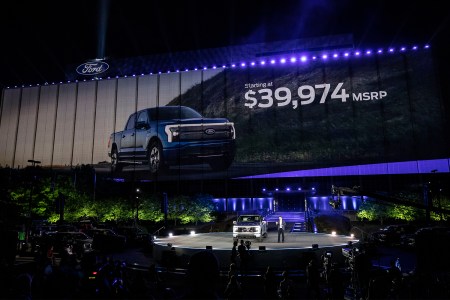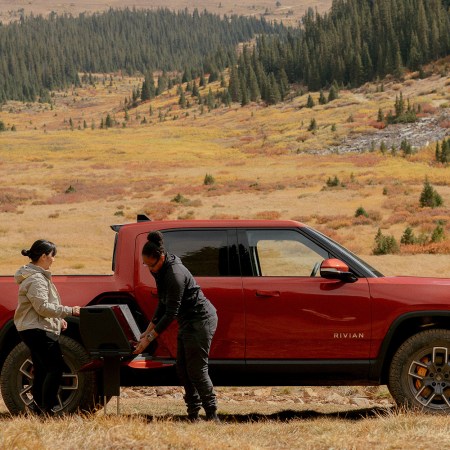The Columbia River Gorge opens up quickly once you head east out of the Portland suburbs.
The start of the northern corner of the National Scenic Area is almost a suburb in itself, beginning where the Sandy River meets the Columbia and civilization generally ends, save for a few small communities. The interstate molds itself along the bends of the Columbia heading east until the greenery turns a bit more tan, the air a bit drier 70 miles away past The Dalles.
In short, it’s a great drive with plenty of rural and off-road opportunities both on the Oregon and Washington sides of the Columbia. This is a stretch of earth molded by its own weather patterns and microclimates, even when things seem peachy back in Portland. In the middle of a Pacific Northwest winter, it’s typically unpredictable, and thus an ideal proving ground for the next generation of the country’s best-selling truck, powered by electricity.
As I descended north from nearby Mt. Hood back to the interstate, the Ford F-150 Lightning I was testing highlighted its potential on open roads, where it excels most. An eerie quiet surrounds the electric pickup truck as it glides by slower traffic, making almost no noise as it speeds up.
I first experienced this preternatural grace back in my driveway, easing out into traffic. The 6,015-pound, four-door truck moved with such ease that I had to stop suddenly to avoid becoming a blockade on my neighborhood street.
Acceleration and speed are great, but not the entire package when it comes to what the average American truck buyer wants. The entire F-Series lineup is widely popular as a reliable, versatile and enduring example of automotive Americana, giving plenty of buyers what they need (or crave) in something that works as a hauler and daily driver.
Ushering in the next, necessary generation of American consumer trucks requires finesse and significant selling of a mindset shift, a tall task even for a storied automaker like Ford. Truck buyers are going to have a rapidly-growing stable of options to meet their needs, and the Lightning is a well-executed example of what could be.

Range Not as Advertised
Although Ford claims you can get up to 300 miles of range with the extended-range battery that was included in my top-line Platinum model, I did not enjoy anything close to that. (Other trim models, like the Lariat and XLT, promise up to 320 miles with the larger battery, while the standard battery supposedly offers 240 miles in other trim levels.) My tester showed 217 miles of range at full charge. This was after charging overnight with the supplied (Level 2, 240V) Ford Mobile Power Cord at home and in around 35-40 degrees.
For around-town driving, 217 miles will certainly suffice. But, on that same road trip through the Gorge, I found mileage depleting rather quickly, which curbed any plans to get the rig off the pavement and into some serious testing ground. I had enough range to get to the mountain, but I had to visit a Walmart parking lot to grab enough juice from an Electrify America station to make it back home afterwards (specifically, from a DC fast charger that can juice the battery up to 80% capacity in around 20 minutes). The reliability and availability of fast chargers remains an issue, and one that can hopefully be improved in the years ahead as the EV market requires it.
The Fleeting Dream of a $40,000 Electric Truck
Ford appeared to do the impossible with the F-150 Lightning, but regular price increases show it was just thatThe thing you need to understand about “estimated” range on EVs like this? It’s an estimate. There are far too many variables to accurately predict the range you’ll get without spending time behind the wheel. Ford claims to have an answer for this with its integrated Intelligent Range system, which takes a number of factors into account to estimate range, but it’s hard to understand how that factors into the overall driving experience since it exists largely in the background. If you’re expecting to get exactly what Ford advertises as potential range, I would be wary. Whether due to the car calculations or external conditions, I simply did not experience what Ford says you can achieve in overall mileage. [Editor’s note: Electric vehicles, like gas-powered ones, experience lower driving range in cold weather. You can read our previous coverage on the issue, as well as our other first-hand tests.]
Further, towing is going to be a shortcoming with electric trucks for the foreseeable future. Although the Lightning has a capacity up to 10,000 pounds on certain models (up to 8,600 pounds on the Platinum), towing anything — or hauling a big load in the truck bed — will drain the battery quickly. That same trip I made to the Gorge would not have been possible on one charge had I been towing a camper of any size.

Large and in Charge
It’s hard to grasp how big the Lightning is until you see it in person. It comes in at 232-inches long, 80-inches wide and 77-inches high, and is currently only available in a crew cab design with a 5.5-foot bed. It feels like an F-250.
To maneuver a truck of this size means running over the occasional curb in the parking lot, and probably finding an alternative for cramped downtown streets. Further disorienting the driver is how nimble and agile a truck of this size is on the freeway. It simply moves. There’s no bending from the rear, no gaps in torque, just the smooth easing of 0-60 in four seconds, and that is simply a joy to experience time and time again.

Infotainment Upgrades to Come
The first-generation Lightning represents the last generation of Ford’s love-it-or-hate-it Sync infotainment system, which will go through a big evolution as the carmaker aligns with Google and Android, an upgrade supposedly set to launch sometime this year.
My first experience with the modern Sync system was in a Ford Mustang Mach-E last year, and I found it to work just fine for my basic needs: I could find essential controls (temperature, GPS, music, etc.), connect easily to Apple CarPlay and figure out where upcoming EV chargers might be.
While it’s not the most intuitive system, and there remains some disconnectivity between the FordPass app and the in-car system, I never had that familiar feeling of frustration when trying to figure out how to adjust climate control, which has become more common in new vehicles.

An Expensive Proposition
The price is certainly eye-opening. My Platinum model is currently priced at $96,874 MSRP. Compared to a similarly-equipped Rivian, that’s not awful. Compared to a gas-powered F-150? There’s at least a $20,000 difference, a potentially hard sell for the average pickup buyer. The base Lightning Pro models do start at $55,974, but those are intended more as work trucks for the commercial market. Even so, it would be hard to buy a Lightning without the extended-range battery if you need a truck to do truck things, which catapults pricing north of $80,000.
There’s also the availability problem. Supply-chain and other issues continue to plague the rollout of the Lightning, with a Ford rep confirming that the company is still working through the initial 200,000 reservation holders who ordered a truck, and won’t be ramping up production rates until this fall. For the few Lightnings that trickle down to dealers, there’s a long, competitive waitlist and huge markups. Inevitably, prospective Lightning buyers will also look at the Rivian R1T, but there are similar availability issues there. (However, I’ve seen a smattering of used Rivians and Lightning on the market now for those who want them.)
With all of this in mind, the F-150 Lightning feels like it’s ready for this moment in electric driving. For the day-to-day truck driver, running errands around town and hauling supplies, it’s essentially a turnkey experience. Considering the F-150’s multi-decade run as America’s best-selling vehicle, it’s a groundbreaking achievement.
Looking at the F-150 Lightning from a high view, it’s not ready to be the do-it-all answer for long hauls and road trips in the way its traditionally-powered siblings are. What it is ready to do is move the needle and the thinking of a vehicle that a significant number of American buyers turn to, and that’s a major milestone.
Sure, most pickup buyers will need the extended-range version to make it worth their time (with the added expense), but this is a truck ready to slot right into the segment and compete. There are few misgivings and even fewer concessions, just a very capable truck sans exhaust pipe.
This article was featured in the InsideHook newsletter. Sign up now.






















